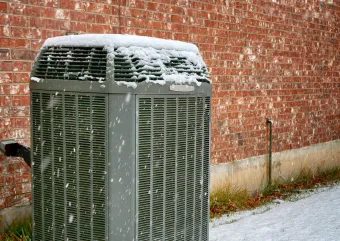Are you interested in a heat pump for your home but want to be sure it will work when the temperature dips below freezing? You’re not alone. Many homeowners are asking this question as they consider replacing their traditional heating systems with all-electric heat pumps. The good news is that modern heat pump technology can effectively cool and heat in cold climates, including Minnesota.
Why consider a heat pump for heating and cooling?
As the Minnesota market grows, installing a heat pump is becoming increasingly cost-effective. New systems can reduce energy consumption by as much as 55%, with the highest savings coming from homes with electric resistance or propane heating. To help homeowners offset installation costs, utilities throughout the state are offering generous heat pump rebates.
How do heat pumps work?
Heat pumps extract heat from outside air and move it inside. They also efficiently cool like a traditional air conditioning (AC) unit, moving heat from inside to outside. Even in temperatures well below zero, heat pumps can take advantage of the heat in the air. Cold climate equipment is highly efficient in temperatures down to 5oF and in some cases will heat in temperatures as cold as -20oF, greatly reducing the need for a backup heating system.
Will you still need a backup heating system to supplement your heat pump in Minnesota? Yes, but with the correct settings your heat pump will keep your home comfortable during most winter days.
Why are heat pumps more efficient than traditional fuel systems?
Even the most efficient boiler or furnace can't achieve 100% efficiency because some heat energy from combusting fuel is always lost. However, high efficiency heat pumps can achieve efficiencies of 400% and above, meaning for each unit of energy the heat pump uses, four or more units of heat are delivered to the home.
The main reason for this impressive cold weather performance is recent technological advancements in variable-speed, inverter-driven compressors. An inverter-driven compressor maintains a constant temperature by varying speed, or modulating, to match the heating or cooling load of the home. Think of it like cruise control in your car. You get better gas mileage when you’re cruising down the highway than in stop-and-go traffic. Traditional HVAC equipment turns on and off regularly, which is inefficient. The most efficient way to operate HVAC equipment is to keep it running, and inverter driven systems do that automatically.
Are all heat pumps capable of heating in sub-zero temperatures?
Not all heat pumps are designed to operate below 0°F. Standard heat pumps deliver heat efficiently and effectively down to about 20oF. Standard equipment operates the same way as cold climate equipment but doesn’t cover as much of the heating load. Depending on what your needs and goals are, going with standard equipment might be the best choice. These units aren’t as expensive as cold climate units but are still highly efficient and can significantly reduce energy bills.
Looking for more guidance?
To learn more about heat pumps, continue exploring News & Case Studies or visit the FAQs page. If you have further questions, contact us at info@mnashp.org.
Author
Connect with a local contractor


